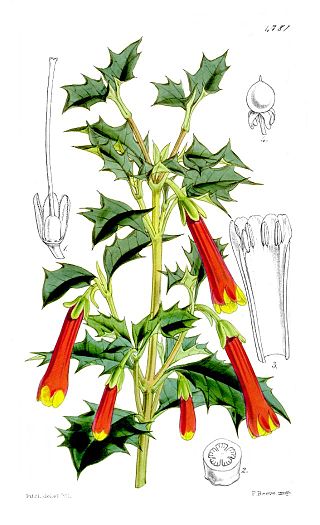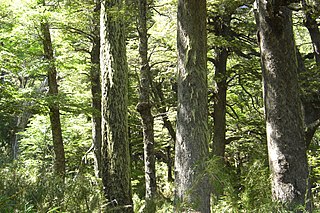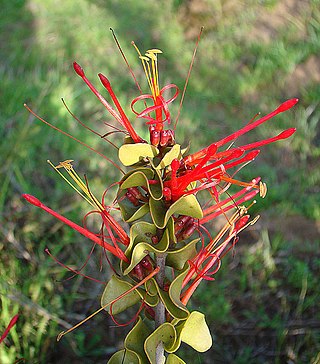
Marsupials are a diverse group of mammals belonging to the infraclass Marsupialia. They are primarily found in Australasia, Wallacea, and the Americas. One of the defining features of marsupials is their unique reproductive strategy, where the young are born in a relatively undeveloped state and then nurtured within a pouch.
Colocolo, colo-colo, Colo-Colo, or Colo Colo may refer to:

Microbiotheria is an australidelphian marsupial order that encompasses two families, Microbiotheriidae and Woodburnodontidae, and is represented by only one extant species, the monito del monte, and a number of extinct species known from fossils in South America, Western Antarctica, and northeastern Australia.

Microbiotheriidae is a family of australidelphian marsupials represented by only one extant species, the monito del monte, and a number of extinct species known from fossils in South America, Western Antarctica, and northeastern Australia.

The Cordillera de Oncol is a mountain range, located along the Pacific coast in southern Chile. It is part of the Chilean Coast Range System. It was named for the city of Valdivia. The highest point of the range is Cerro Oncol, at 715 m.

The Valdivian temperate forests (NT0404) is an ecoregion on the west coast of southern South America, in Chile and Argentina. It is part of the Neotropical realm. The forests are named after the city of Valdivia. The Valdivian temperate rainforests are characterized by their dense understories of bamboos, ferns, and for being mostly dominated by evergreen angiosperm trees with some deciduous specimens, though conifer trees are also common.

Ameridelphia is traditionally a superorder that includes all marsupials living in the Americas except for the Monito del monte (Dromiciops). It is now regarded as a paraphyletic group.

Australidelphia is the superorder that contains roughly three-quarters of all marsupials, including all those native to Australasia and a single species — the monito del monte — from South America. All other American marsupials are members of the Ameridelphia. Analysis of retrotransposon insertion sites in the nuclear DNA of a variety of marsupials has shown that the South American monito del monte's lineage is the most basal of the superorder.

The long-nosed caenolestid, also known as the Chilean shrew opossum or long-nosed shrew opossum, is a shrew opossum that occurs in temperate forests of Argentina and southern Chile. It was first described by American zoologist Wilfred Hudson Osgood in 1924. The long-nosed caenolestid resembles Caenolestes species in morphology. It is characterized by a long, pointed snout, small eyes and ears, and one claw on a digit of each of the thin limbs. Little is known of its behavior; it appears to be terrestrial, nocturnal and omnivorous. It prefers cool, moist areas, and has a small distribution. It is classified as near threatened by the IUCN.

Los Ruiles National Reserve is a small nature reserve located in Cauquenes Province of Maule Region in central Chile. The reserve consists of two sections that protect enclaves of native forest, which are home to several threatened and endangered species.

Desfontainia is a genus of flowering plants in the family Columelliaceae, though it was placed formerly in Loganiaceae, Potaliaceae, or a family of its own, Desfontainiaceae.

Vicente Pérez Rosales National Park is located in Los Lagos Region, Llanquihue Province, of Chile. Its western entrance is close to the Ensenada locality, 82 km (51 mi) northeast of the provincial capital of Puerto Montt, and 64 km (40 mi) from Puerto Varas along Ruta CH-225. This national park covers about 2,530 km2 (977 sq mi) and is almost entirely in the Andes mountain chain. The adjacent national parks Vicente Pérez Rosales and Puyehue National Park in Chile, and Nahuel Huapi National Park and Lanín National Park in Argentina, provide a continuous protected area of close to 15,000 km2 (5,792 sq mi).

Tolhuaca National Park is a protected area created on October 16, 1935, in an area of 3,500 ha that was previously part of the Malleco National Reserve. In 1985, a second section of Malleco National Reserve was also made part of the national park. Malleco National Reserve was the first protected wildlife area in both Chile and South America, so the land within Tolhuaca National Park is one of the oldest protected areas on the continent.

Tristerix is a genus of mistletoe in the family Loranthaceae, native to the Andes, ranging from Colombia and Ecuador to Chile and Argentina. They are woody perennials usually occurring as aerial parasites, are pollinated by hummingbirds and flowerpiercers, with seed-dispersal generally by birds but occasionally by mammals (Dromiciops). The genus is distinguished from other New World Loranthaceae by its simple, terminal, racemose inflorescences, together with its of 4- or 5-merous flowers, versatile anthers, and the presence of endosperm. Further differences include fused cotyledons and the absence of epicortical roots.

Las Vertientes Private Nature Reserve is a private Chilean nature reserve located in the Los Lagos Region, part of Chilean Patagonia. Created in 2009 as a nature reserve operated by the Corporación Nacional Forestal, its purpose is to protect the plants and animals of the Valdivian temperate rainforest. The 100 square kilometres (39 sq mi) reserve's work emphasizes restoration of the temperate rainforest ecosystem over being a public amenity. It is the only private protected area in Los Muermos.

Ixodes neuquenensis is a species of tick that lives on the monito del monte, a nocturnal marsupial that lives in the temperate forests of southern South America. Due to the near-threatened status of its host, Ixodes neuquenensis is also at risk.

Bosque Andino Patagónico, also known as Patagonian Andean forest, is a type of temperate to cold forest located in western Patagonia in Argentina and also in southern Chile, at the southern end of South America. The climate here is influenced by humid air masses moving in from the Pacific Ocean which lose most of their moisture as they rise over the Andes. The flora is dominated by trees, usually of the genus Nothofagus.
Clenia is an extinct genus of marsupials from the Oligocene and Miocene of South America. They are relatives of the living monito del monte (colocolo).

Tristerix corymbosus is a species of Tristerix found in Chile at elevations of 0 to 2075 meters. It is a preferred source of fruit for the monito del monte.




















